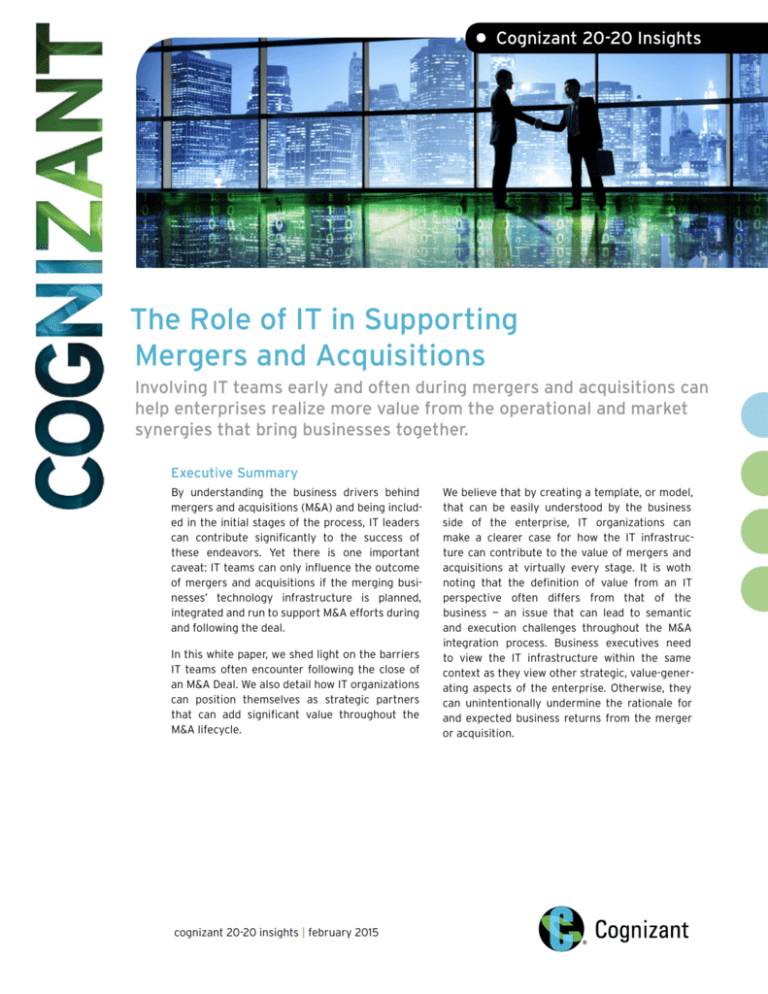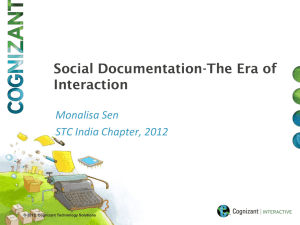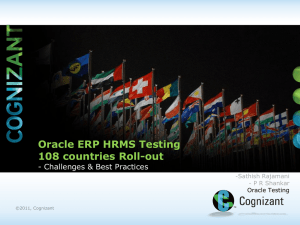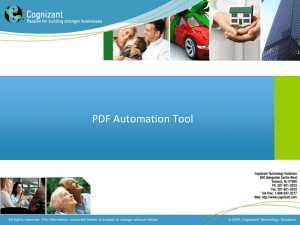
• Cognizant 20-20 Insights
The Role of IT in Supporting
Mergers and Acquisitions
Involving IT teams early and often during mergers and acquisitions can
help enterprises realize more value from the operational and market
synergies that bring businesses together.
Executive Summary
By understanding the business drivers behind
mergers and acquisitions (M&A) and being included in the initial stages of the process, IT leaders
can contribute significantly to the success of
these endeavors. Yet there is one important
caveat: IT teams can only influence the outcome
of mergers and acquisitions if the merging businesses’ technology infrastructure is planned,
integrated and run to support M&A efforts during
and following the deal.
In this white paper, we shed light on the barriers
IT teams often encounter following the close of
an M&A Deal. We also detail how IT organizations
can position themselves as strategic partners
that can add significant value throughout the
M&A lifecycle.
cognizant 20-20 insights | february 2015
We believe that by creating a template, or model,
that can be easily understood by the business
side of the enterprise, IT organizations can
make a clearer case for how the IT infrastructure can contribute to the value of mergers and
acquisitions at virtually every stage. It is woth
noting that the definition of value from an IT
perspective often differs from that of the
business — an issue that can lead to semantic
and execution challenges throughout the M&A
integration process. Business executives need
to view the IT infrastructure within the same
context as they view other strategic, value-generating aspects of the enterprise. Otherwise, they
can unintentionally undermine the rationale for
and expected business returns from the merger
or acquisition.
>>
A Short Story
It is 9:AM on a Monday morning — time for the weekly M&A integration status meeting. In keeping with
the tradition at his company, a global manufacturer, the IT leader responsible for all the technological
aspects of the M&A integration attends the meeting — joined by his integration team, as well as a full
ensemble of functional stakeholders, including corporate development, the originators of the acquisition, and the keepers of the synergy commitments to the board and “the Street.”
The IT team has carefully documented their progress, as well as any issues and risks, in their status
reports. The IT leader is set to announce that the item setup time in the product lifecycle management
tool is slipping, since new SKUs were added the previous week.
The meeting starts with a discussion of the latest functional requirements. The IT head is surprised to
learn that the list of open requirements has grown. How could this happen? Doesn’t everyone understand the impact on the integration schedule — potentially pushing out the timeline? He realizes he will
need to request additional resources, and even if he gets them, the risk level will be that much higher.
After presenting IT’s status and issues, and emphasizing the expected delay in the item setup process,
the IT leader realizes that no one (other than his team) seems concerned that the timeline will be
delayed and that this holdup will impact the planned “Day One” schedule.
As he does every week, the IT head asks the meeting chair to detail the expected synergies of the merger
and how they will be measured going forward. As always, the response is that the synergies issue is
under control and that the IT organization need not worry.
Although the IT head has held his position for many years, this is the first
time he has worked on a post-merger integration initiative. He wonders
how he fits in, and if IT is viewed as a partner in the M&A process, or as
merely a back-office function. If that’s the case, how can his team contribute real business value to the company, including during and following the
M&A process?
Post-Merger Integration: All Aboard
Many IT leaders face these types of challenges
when navigating the M&A integration process,
especially when their company isn’t a seasoned
acquirer. IT teams are often excluded from the
early stages of a deal, but brought in afterward
to reconcile the myriad aspects of two complex IT
organizations quickly and economically. Most of
today’s enterprises depend heavily on the information systems that coordinate transactions,
manage operations, support sales and service,
and provide services around the emerging world
of digital. Yet avoiding disruption while creating
more value is often an afterthought in the M&A
strategy of many enterprises.
Apart from preserving value through more
effective integration, many experienced acquirers create additional value and reduce risk by
involving IT much earlier in the process — often
at the very beginning. One such acquirer is EMC,
the world’s largest data-storage equipment provider. EMC has established a best practice of
cognizant 20-20 insights
Apart from preserving
value through more
effective integration,
many experienced
acquirers create
additional value and
reduce risk by involving
IT much earlier in the
process — often at the
very beginning.
fielding a dedicated IT
M&A integration team
immediately upon signing a letter of intent.1
As IT integration is
core to EMC’s M&A
integration efforts, the
IT team’s presence helps broaden the conversation and illuminate potential areas of opportunity,
operational challenges and financial risks.
M&A Value Creation: A Business Perspective
Traditionally, companies use revenue or shareholder value as an indicator of M&A success.
However, value created from an acquisition is not
limited to the shorter-term view of increasing revenue or immediate cost-cutting. Long-term value
can come in many forms.
A recent survey2 cited a number of additional factors that companies take into account to drive
M&A strategies and create additional value. (See
top of next page.)
2
The top three issues focus on:
•
•
•
Expanding the customer base in existing
markets.
Pursuing cost synergies or scale efficiencies.
Entering new markets.
Irrespective of the source, value from an acquisition depends on successful integration, which
for most companies requires “end-to-end” IT
engagement.
M&A Value Creation: An IT Perspective
There is no doubt that increasing business value
is the incentive behind most mergers and acquisitions. At the same time, defining the role IT plays
in M&A activities can be critical, given that it is
a complex undertaking with multiple dimensions.
The key element is enabling IT to support differentiating business functions, since augmenting
core processes should be an underlying objective
of any acquisition. Our view is that key elements
of IT value creation3 should include:
•
•
Improving IT capabilities to support the
reasons behind the merger. Production
synergies can be enhanced through tighter
coordination of production capacity; support
for a new integrated R&D function; better
vertical integration, and accessibility to
acquired suppliers/clients.
Improving the IT operating model. Organizations need to create an improved version of
the “business of IT” in the newly integrated
enterprise.
The Contributions IT Can Make
to Mergers & Acquisitions
While IT is of course not the sole driver of M&A
integration success, its importance in business integration has long been recognized. For
example, McKinsey once noted that “IT can be
a powerful factor behind M&A success, assuring
synergies are realized and ultimately increasing
the deal-making capacity of acquirers.”4
Traditionally, value creation in mergers was measured in business terms by addressing specific
cost savings related to the consolidation of assets
(e.g., manufacturing plants or branch locations),
or to increased purchasing power that significantly reduced costs through vendor consolidation.
However, the latest studies show that even bigger
savings can be realized by correctly tracking IT
synergies.
IT is widely recognized as an enabler of business
process optimization and business transformation — impacting and supporting a variety of
highly visible functions that drive business value.
In some cases, IT alone is responsible for creating
overall value.
Following are several areas where IT plays a major
role, either as part of IT enablement or as a standalone function:
• Supporting the business case for achieving cost
savings by combining the IT cost structures.
•
• Assuring
end-user satisfaction with the
integrated systems (information quality and
usability). Businesses should avoid disrupting
employees or inconveniencing customers,
and work to ensure corporate-wide access to
accurate, useful and timely information.
•
•
Effective and efficient IT integration
management. Making the best use of time,
costs and personnel during the integration
process, and developing effective management
policies around project management, change
management, IT sourcing, etc., is crucial.
Efficient IT staff integration. IT organizations
must strive to avoid losing key IT personnel and
their expertise, especially in scenarios where
superior technology and best practices reside
within the target (acquired) company.
cognizant 20-20 insights
Reducing overlap of IT in the merged companies
by rationalizing application portfolios and IT
organizations.
• Optimizing
infrastructure landscapes and
determining operating models for the new
entity.
•
Enabling synergies by integrating major
business functions, improving communications,
enhancing processes and providing uninterrupted customer service.
•
Providing operational visibility during the
integration process via communications and
knowledge-sharing portals.
Recent research shows that roughly 50% of
merger value is related to IT synergies. Yet a lot
of the time, IT is not considered during acquisition planning and pre-close, but is expected to
reconcile systems quickly and successfully once
the deal is done. The IT organization should have
a seat at the due diligence table to spot potential
3
obstacles to integration, and assess opportunities for IT transformation beyond integration.
This not only speeds the integration process but
can provide an opportunity to create more value
faster. For example, early involvement of IT teams
can help align key deal areas such as customer
acquisition in existing markets (through the early
integration of customer management systems to
identify existing customers) and enabling marketing to potential new customers.
To fulfill these roles, IT leaders need to:
•
•
•
Pursue a dual IT agenda. IT organizations
should not only plan to integrate and operationalize processes and systems, but also look
for ways to take on a more strategic role in
the business, such as defining a future state IT
operating model, portfolio and process rationalization, and organizational design. These
endeavors can bring higher returns than
simply focusing on combining two companies’
systems or eliminating duplicate positions.
Be a full partner during due diligence. IT
leadership should actively participate in the
pre-close phase. The technology team is in a
unique position to spot potential obstacles to
integration across people, processes and/or
technology. The team can also identify liabilities, such as the lack of a scalable architecture,
security risks, skills gaps, capacity constraints,
license issues and other IT-related financial,
operational and technical risks. And often
most important, IT should be able to identify
if and how leveraging the target technology
platforms can add value to innovation efforts.
Hit the ground running before day one. Integration planning should begin well before a
deal closes so the merged organization can
be operational on day one. The IT integration team should develop a clear strategy for
determining what systems to keep, what data
to migrate; and what processes to follow, as
well as initial organizational structures and
key performance measurements. CIOs also
can use this period as an opportunity to create
value through portfolio rationalization — from
projects to applications, assets, data centers
and specific capabilities.
cognizant 20-20 insights
It is very difficult to forecast
the savings and measure
the efficiencies resulting
from merged R&D or
fulfillment processes without
a deep understanding of the
requirements needed to
integrate these two potentially
disparate IT landscapes that
support very different areas
of the business.
What Factors Help Create Value?
To help maximize business value, IT teams should
focus on the following:
•
Pre-close participation. Involvement by the
CIO as a strategic partner in identifying acquisition opportunities can help to identify areas
where IT can add the most value, as well as
those that carry potential risks. There is no
way to forecast the savings from merged R&D
or fulfillment processes, for example, without
a deep understanding of what is required to
integrate the two potentially disparate information technology landscapes supporting
these very different areas of the business.
•
Risk management. Traditionally, most integrations have focused on avoiding failure — a
strategy that often stymies transformational
change, and the opportunity to heighten performance, enrich value, and compete in new and
more profitable ways. Risk management during
due diligence helps to highlight potential delays
and risks that get in the way of achieving integration targets. Successful business/IT collaborations view M&A success from an investor’s
perspective — taking into account both industry
and market dynamics and, importantly, having
answers to questions around which asset
categories to invest in, change management,
and prioritizing long-term growth, among
other considerations.
• Velocity.
The sooner your organization
completes an M&A integration, the sooner
the benefits can accrue. Increasing the speed
of this task also reduces uncertainty among
employees and customers. Yet speed alone
invites errors — and errors run up costs. Careful
planning and the support of an experienced
4
Quick Take Making M&A Integration Formulaic
After analyzing the requirements, the CoE leads
identify areas of impact and the scope of integration, then relay these insights to the business and
IT teams. All hand-offs between various teams are
streamlined by standardizing and documenting
the process in the playbooks. Based on the scope
of integration, the business and IT teams map the
business requirements and functional requirements respectively.
Following is one example of how a leading virtualization software company’s business and IT
teams work in tandem to achieve faster, smoother M&A integrations. To help assimilate acquired
companies rapidly, consistently and with minimal
disruption, this company forms cross-functional
teams, defines guiding principles and develops
standard processes. Its M&A Center of Excellence
(CoE) is a central group with representation from
multiple business functions, as well as IT, and is
the core of integration execution.
Once the functional requirements are captured,
the CoE handling IT requirements will use the
appropriate resources from the respective development teams to complete the coding and testing
of integrated systems. Budgets and resources are
identified by the IMO and CoE well in advance to
avoid timeline slippages. The business teams conduct user acceptance testing once the systems
are ready. The cut-over plan is then prepared by
the CoE IT team and the systems go live for use
by both companies. The CoE and IMO monitor the
entire cycle of events for any risks or delays in
decisions.
Once the target passes the deal-screening phase,
the due diligence team and the integration
management office (IMO) gather relevant documentation and information to ensure proper due
diligence. If the target meets all requirements, the
deal is signed and the baton is passed to the IMO
and the M&A CoE to plan and execute integration.
The IMO engages with the M&A CoE business and
IT teams, informing them of the acquisition and
initiating integration planning. Tailoring the playbooks for each acquisition, the business team
documents integration requirements and shares
its findings with CoE leads (including those from
sales, global support and IT).
This approach has proven successful — eliminating
the integration backlog in a very short timeframe.
M&A Project Initiation: A Schematic View
Integration
Management
Office
Feedback
throughout
= Deliverable
Feedback
throughout
CoE Team
Sale Ops GSS
Lead Lead
1.
Initiate project
CoE
Leads
IT
PM
Business
PM
Business
BAs
2.
Gather requirements
using the playbooks
3.
Identify ares of impact
and scope
4.
Document business
requirements
Business
requirements
documents
6.
Code development/
QA Testing
IT
PM
Business Business
PM
BAs
7.
UAT
Sign-off
cognizant 20-20 insights
5
5.
Document functional
requirements
Functional requirements
documents
Development
& Quality
Assurance
(Not part of core
business team)
IT
BAs
IT
BAs
Project
go-live
8.
Production cut-over plan
Cut-over plan
team that understands typical integration
activities, dependencies, risks and challenges
can help accelerate the integration process.
Whether this team is in-house or virtual doesn’t
matter, as long as the roles and responsibilities
of key stakeholders are clarified early on.
•
Repeatable processes. Tailored, repeatable
processes and M&A playbooks can help unlock
the value and speed the pace of the M&A
process. M&A playbooks should be shared and
embedded across the organization. Companies
should develop proven methodologies and
templates, and use them to integrate acquired
entities and fast-track integration planning and
execution. While these tools can be applied
directly to most acquisitions, companies can
tailor them, depending on business needs. The
key is to develop an approach that fosters consistency, predictability and reusability.
Looking Forward: Top-of-Mind Issues
The courage to move beyond risk avoidance is the
starting point for accelerating value in a merger
or acquisition. When focused on accelerating
value creation, business and IT leaders should
challenge themselves and their teams to:
•
Have a clear understanding of how IT can
support the future state vision post-integration.
•
Hand-pick leaders of integration teams/integration management office.
•
Develop the ability to identify, measure and
execute the planning of both combinational
and transformational synergies.
•
Resolve issues around culture, people and
power to win the hearts and minds of all constituents impacted by the merger/acquisition.
•
Develop a structured, repeatable integration process that is flexible enough for future
acquisitions.
Final Thoughts
As technology continues to evolve and is increasingly aligned with strategic imperatives, it will
become even more critical for IT to not only have
a seat at the table during the M&A process, but to
be recognized as a full partner with the business
in unlocking maximum value from an M&A deal.
For decades, IT leaders have struggled to identify,
manage and successfully deliver business value
following an acquisition. But this is not IT’s responsibility alone; rather, key business stakeholders
should be equally responsible for ensuring that
business advantage is delivered through IT integration. IT by itself is never the sole reason to
conduct a merger; however, poor IT integration
can certainly undermine a deal’s expected value.
No business leader involved in a merger or
acquisition can afford to forfeit 50%-plus of its
envisioned value by failing to address the IT synergies needed to fulfill the promise of such an
undertaking. As such, business operations must
partner with the IT organization early and often to
create a platform for engaging key IT team members throughout all stages of the M&A lifecycle.
Historically, IT had to fight an uphill battle to
meet tight deadlines and allocate already thin
resources to support M&A integration. To improve
the odds of M&A success, organizations must
ensure that both IT and operations are accountable for risks and rewards. The first step is for
senior management to gauge how business and
functional leaders enable IT to support and generate value from M&A deals.
Afterword
We are preparing to conduct a survey of key IT
leaders across the globe to learn more about
their point of view on success factors from an
IT perspective during the M&A integration process. The results of this survey will help to shed
light on the difficulties we see today and define a
framework for helping IT leaders create additional value during future deals.
The findings are expected to identify the challenges IT leaders face during integrations and will
help define the multidimensional nature and definition of IT integration success. For more details,
please contact inquiries@cognizant.com.
cognizant 20-20 insights
6
Footnotes
1
IT Integration for Mergers and Acquisitions. EMC. July 2012. http://www.emc.com/collateral/software/
white-papers/h10775-emc-it-integration-mergs-acqs-wp.pdf.
2
M&A Trends Report 2014 — A comprehensive look at the M&A Market. Deloitte. http://www2.deloitte.com/
us/en/pages/mergers-and-acquisitions/articles/mergers-and-acquisitions-trends-report-2014.html.
3
Evaluating Success in Post-Merger IS Integration: A Case Study. Maria Alaranta, Turku Centre for
Computer Science. Lemminkaisenkatu, Finland. http://issuu.com/academic-conferences.org/docs/
ejise-volume8-issue3-article560?e=1257060/3625247.
4
Understanding the Strategic Value of IT in M&A. McKinsey Quarterly, January 2011. http://www.mckinsey.
com/insights/corporate_finance/understanding_the_strategic_value_of_it_in_m_and_38a.
About the Authors
Robert Asen leads Cognizant Business Consulting’s Strategic Services practice in North America — focusing on cross-industry management and technology strategy. Rob’s expertise addresses IT post-merger
integration, CIO advisory services, and business and IT process optimization, with special emphasis on
digital enablement and change management. During his 25-year career, Rob has worked with some of
the top industry and “Big-Four” corporations in areas that include consulting on senior-level business
strategy, business performance and technology transformation programs. He holds BS and MS degrees
from the State University of New York at Albany. Rob can be reached at Robert.Asen@cognizant.com.
Jan Diederichsen is a Senior Director within Cognizant Business Consulting’s Strategic Services Practice
and the M&A/PMI Service Line Leader for North America. For over 16 years, he has worked with 20-plus
companies on operational and IT-related due diligence initiatives and more than 30 companies on strategic divestiture and PMI planning projects, leading several end-to-end post-merger integrations and
business transformation initiatives. Jan’s expertise spans the life sciences (medical devices, in particular), retail, travel and transportation industries. He holds a BBA from GSBA Zurich (CH) and an MBA from
University of Wales, Cardiff (UK). He can be reached at Jan.Diederichsen@cognizant.com.
Kyle Robichaud is a Senior Manager within Cognizant Business Consulting’s Strategic Services Practice
and M&A/PMI Service Line. For the past 10 years, he has worked with dozens of organizations in helping
to develop IT strategies and roadmaps for integrations/separations and overall IT operations. His experience spans multiple industries, including life sciences, retail, finance and high technology. He holds BS
and MS degrees in Information Systems from Marist College in Poughkeepsie, NY. He can be reached at
Kyle.Robichaud@cognizant.com.
Pallavi Sinha is a Senior Consultant within Cognizant Business Consulting’s Strategic Services Practice.
She has five-plus years of experience working with technology, retail and manufacturing companies on
PMI and business transformation initiatives. She received her engineering degree from BIT Mesra and
holds an MBA from IIM Calcutta. She can be reached at Pallavi.Sinha@cognizant.com.
About Cognizant
Cognizant (NASDAQ: CTSH) is a leading provider of information technology, consulting, and business process outsourcing services, dedicated to helping the world’s leading companies build stronger businesses. Headquartered in
Teaneck, New Jersey (U.S.), Cognizant combines a passion for client satisfaction, technology innovation, deep industry
and business process expertise, and a global, collaborative workforce that embodies the future of work. With over 75
development and delivery centers worldwide and approximately 211,500 employees as of December 31, 2014, Cognizant is a member of the NASDAQ-100, the S&P 500, the Forbes Global 2000, and the Fortune 500 and is ranked among
the top performing and fastest growing companies in the world. Visit us online at www.cognizant.com or follow us on
Twitter: Cognizant.
World Headquarters
European Headquarters
India Operations Headquarters
500 Frank W. Burr Blvd.
Teaneck, NJ 07666 USA
Phone: +1 201 801 0233
Fax: +1 201 801 0243
Toll Free: +1 888 937 3277
Email: inquiry@cognizant.com
1 Kingdom Street
Paddington Central
London W2 6BD
Phone: +44 (0) 20 7297 7600
Fax: +44 (0) 20 7121 0102
Email: infouk@cognizant.com
#5/535, Old Mahabalipuram Road
Okkiyam Pettai, Thoraipakkam
Chennai, 600 096 India
Phone: +91 (0) 44 4209 6000
Fax: +91 (0) 44 4209 6060
Email: inquiryindia@cognizant.com
­­© Copyright 2015, Cognizant. All rights reserved. No part of this document may be reproduced, stored in a retrieval system, transmitted in any form or by any
means, electronic, mechanical, photocopying, recording, or otherwise, without the express written permission from Cognizant. The information contained herein is
subject to change without notice. All other trademarks mentioned herein are the property of their respective owners.
TL Codex 1042







